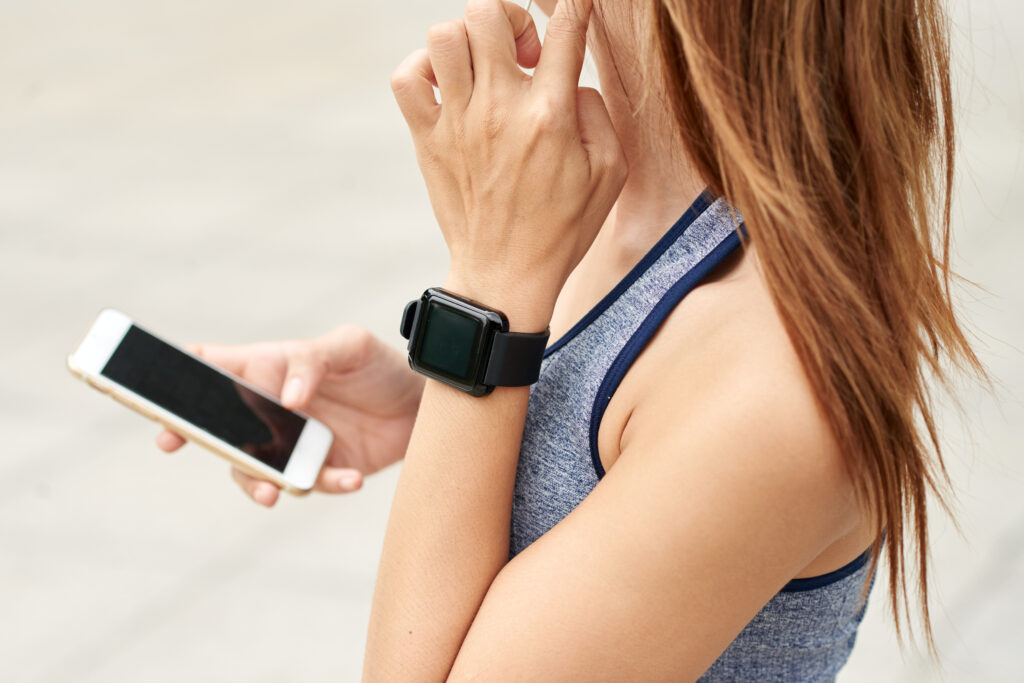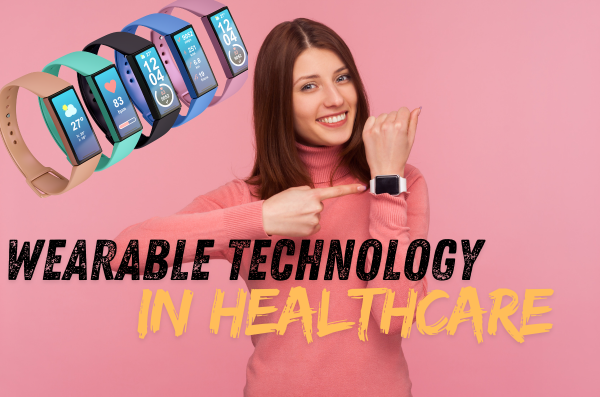Table of Contents
Introduction: Wearable Technology in Healthcare
Wearable technology is transforming the healthcare landscape and revolutionizing the monitoring of
health statuses by both individuals and health professionals. Such devices are not merely limited to
smartwatches, fitness trackers, and biohacking tools but are powerful tools that provide insight into the
health status of an individual-from heart rate to sleep patterns to biochemical levels of blood glucose. It
is revolutionizing the management of health by shifting focus away from reactive treatments towards
proactive and preventive care, and that’s being made possible through continuous data gathering. As
such devices evolve, they will enable better and improved personalized health care, patient outcomes,
and a diminished burden on healthcare delivery systems.


How these wearables technology are transforming health monitoring and preventive care
Here’s a detailed look at how these wearables are transforming health monitoring and preventive care.
- Ongoing Health Monitoring
By tracking vital signs and activities, wearables enable constant and real-time vital sign and activity
tracking, which is much more advanced than using periodic doctor visits or random checkups for
monitoring health.
● Smartwatches like Apple Watch, Samsung Galaxy Watch, and many others are equipped with
features such as heart rate monitoring, tracking sleep, and even ECG (electrocardiogram). They
help the users monitor heart health by diagnosing abnormalities, such as AFib, which, if
unnoticed at an early stage, can lead to strokes. Smartwatches may also track blood oxygen
(SpO2) levels and levels of stress based on HRV analysis, so users may notice possible problems
with cardiovascular or respiratory systems beforehand.
● Fitness Trackers, For instance, Fitbit, Garmin, and Whoop are aimed to push the user into physical activities because they calculate the steps, calories burnt, and exercise routines performed. Maintaining an active lifestyle is a big step in preventing obesity, heart disease, and type 2 diabetes. Most of the fitness trackers come with the daily and weekly goals in order to urge the user to achieve their given activity target on a daily basis to gradually improve their health outcomes.
● Biohacking Devices: Those devices intended to interact with the body’s natural functions allow people to monitor bodies in a much more innovative way. Rather than checking blood sugar levels every now and then, continuous glucose monitors alert diabetes patients in real time that their insulin or diet requires adjustment. Oura ring or biometric implants enable those without diabetes access to detailed statistics of their sleep cycles, body temperatures, or recovery. This real-time tracking equips people with knowledge and control over their health while enabling healthcare providers to have a more holistic vision of a patient’s overall well- being, hence improving the management of chronic conditions such as heart disease, diabetes, and sleep disorders. - Monitoring Diseases Early and Its Prevention
The most significant benefit of wearables is that they detect early warning signs in cases related to health problems. All anomalies caught before they appear as serious conditions will make these devices useful preventive tools in cutting down the possibility of happening severe health events.
● Cardiovascular Monitoring: Smartwatches now come with ECG sensors-which can detect abnormal heart rhythms, such as AFib. Early detection is critical because AFib can lead to blood clots, strokes, and heart failure. Numerous studies have shown that access to these features increases the likelihood of a visit to the doctor when the wearer gets an abnormal reading, meaning interventions are sooner.
● Sleep Apnea and Respiratory Issues: Wearable devices will monitor sleep and flag sleep apnea or other breathing conditions such as detection of a still body by the Fitbit Sense or Withings Sleep Analyzer. Early recognition can prevent complications such as high blood pressure, stroke, and heart disease. If users enable sleep stage and disturbance data reporting to their wearables, they can improve the quality of their sleep, which is essential for a healthy lifestyle.
Monitoring Diseases Early and Its Prevention
The most significant benefit of wearables is that they detect early warning signs in cases related to health problems. All anomalies caught before they appear as serious conditions will make these devices useful preventive tools in cutting down the possibility of happening severe health events.
● Cardiovascular Monitoring: Smartwatches now come with ECG sensors-which can detect abnormal heart rhythms, such as AFib. Early detection is critical because AFib can lead to blood clots, strokes, and heart failure. Numerous studies have shown that access to these features increases the likelihood of a visit to the doctor when the wearer gets an abnormal reading, meaning interventions are sooner.
● Sleep Apnea and Respiratory Issues: Wearable devices will monitor sleep and flag sleep apnea or other breathing conditions such as detection of a still body by the Fitbit Sense or Withings Sleep Analyzer. Early recognition can prevent complications such as high blood pressure, stroke, and heart disease. If users enable sleep stage and disturbance data reporting to their wearables, they can improve the quality of their sleep, which is essential for a healthy lifestyle.
● Glucose Monitoring: Continuous glucose monitors are used primarily in diabetic patients to monitor blood glucose levels in real time. With the use of such monitors, the patient would be able to spot spikes or drops in his glucose level and thus avoid hypoglycemia or hyperglycemia, which can be potentially life-threatening. Thus, it allows better and accurate management of diet, exercise, and medication to prevent complications like nerve damage, kidney failure, and cardiovascular disease. - Personalized Preventive Care
Wearables are great at giving one necessary customized health insights that are priceless in preventive care. Unlike traditional healthcare measures offering generalized advice, wearables provide data specifically uniquely pertinent to an individual’s unique physiology and lifestyle.
● Health Insights: Wearables then continue to collect data on heart rate, sleep patterns, levels of
activity, and stress markers, and give health-improvement advice to users. For instance, if the
user’s smart watch shows poor quality of sleep over several nights, it may advise the user to
wake up earlier or avoid too much caffeine.
● Changes in Lifestyle: Fitness watches promote physical activity since they help set targets for
the day, such as steps taken or calories burned. It also tracks some activities such as running,
swimming, or cycling, and allows users to note which activities to improve on. Utilizing fitness
watches has been known to contribute to increased activities that must be maintained in staying
fit, reducing cholesterol levels, and avoiding lifestyle diseases.
● Manageability of Chronic Diseases: Wearables can be immensely helpful for a patient who
suffers from hypertension, diabetes, or asthma. Those devices that can actually monitor the blood pressure, blood sugar, or oxygen saturation allow continuous, remote management of chronic diseases. Real-time monitoring will make it possible for the patient to take immediate adjustments in their medications, diet, or exercise according to the reading done by the wearable without eventual spikes or drops in health metrics. - Integration into Healthcare and Telemedicine
Wearables can change healthcare delivery by integrating into the existing healthcare systems and
remotely monitoring patients. This totally not only shifts some loads from healthcare providers but also makes better outcomes for patients.
● Remote Patient Monitoring: Wearable devices can send the health data of the patient in real-
time to healthcare providers. This way, providers can keep track of patients from a distance. A
smartwatch that tracks the heart rate of a patient will alert a doctor in case of any abnormal
reading. Similarly, continuous glucose monitors send data to healthcare providers and fine-tune
treatment plans. It is especially advantageous to patients who have chronic conditions like
diabetes, hypertension, or heart disease as it minimizes regular visits at the doctor’s office while
allowing for early intervention.
● Telemedicine Synergy: Wearables complement telemedicine platforms by giving physicians raw health data during teleconsultation. Recent health trends coming from a patient’s wearable, such as average heart rate, quality of sleep, and levels of activity, will facilitate better discussions over a call session. This synergy can also be useful for post-operative recovery or conditions where constant monitoring may be required but follow-up visits are not usually necessary.
● AI and Predictive Analytics:But this process also can feed its output into the AI systems that analyze health trends over time and determine patterns signifying emerging health issues. Such platforms will notify users or healthcare providers of probable health risks, like increased chances of having heart disease. Such prediction and prevention of future health issues are highly advanced in value-based care. - Challenges and Concerns
● Wearable technology, however has its associated challenges that need to be addressed in order
to maximize use of these gadgets in healthcare: Data Confidentiality and Security: Wearables collect sensitive health data, thus it raises a lot of questions and cyber threats against health data. Good security measures must be put in place to guarantee protection of users’ personal health data against exploitation.
● Accuracy and Reliability: Although accuracy in wearables has improved dramatically, there are
still some metrics-such as calorie counts or heart rate variability-that may remain incomparable
at times. Data that is reliable from wearables can help a long way to make healthy decisions
effectively.
● User Engagement: Use of wearables requires sustained engagement by the user with the
device. It happens to be a primary reason why fitness trackers fail after some time; users fail to
maintain usage and don’t comply with the recommendations made for their health.
Frequently Asked Questions(FAQs): Get the Answers You Need!
1. What is a wearable device and how is it used in the health sector?
Healthcare-related wearable devices refer to equipment such as smartwatches, fitness trackers, and biohacking devices, designed for monitoring health parameters including heart rate, sleep, activity, and glucose levels. Such devices give real-time continuous monitoring, ensuring the person, as well as caregivers, can track health trends or monitor chronic conditions or even detect early stages of a disease.
2. What do smartwatches offer in the scope of health monitoring?
Just like the Apple Watch and Samsung Galaxy Watch, several health metrics available to be tracked include heart rate, sleep patterns, activity levels, and in some cases, electrocardiograms (ECGs) and blood oxygen levels (SpO2). Altogether, these features ensure smartwatch wearers are able to track their cardiovascular health, monitor for irregular heart rhythms such as atrial fibrillation, and pay attention to the quality of their sleep, all doing so to establish superior health.
3. How do Fitbits enhance preventive care?
Fitness trackers in the form of Fitbit and Garmin monitor daily activities such as steps taken, calories burned, and the intensity of exercises carried out. They keep the users fit by motivating them to lead active lifestyles, which prevents a host of diseases such as obesity, heart disease, and diabetes. The tracker sets goals for activity or progress in activity, which motivates users to be more proactive about fitness and health maintenance.
4. What are biohacking devices? How do they differ from others?
Biohacking devices are far more advanced wearables that directly interact with the body’s physiological functions. For example, continuous glucose monitors are used by patients who are diabetic to track their blood sugar levels continuously. Generally, biohacking wearables work on managing some particular health condition, unlike the other general-purpose wearables, such as smartwatches or fitness watches, which give you less accurate and specific data.
5. How do wearables assist in the early identification of potential health conditions?
Wearables can detect early warning signs of potential health issues. For instance, a smartwatch with an ECG sensor can easily diagnose abnormal heart rhythms that may indicate problems such as atrial fibrillation, giving the users ample time to seek medical help before a major event. Continuous glucose monitors warn diabetics about blood sugar spiking and dropping, thus preventing them from dangerous
spikes or drops that could lead to complications.
6. Can wearables contribute to chronic disease management?
Absolutely, wearables play a great role in the management of chronic conditions such as diabetes mellitus, hypertension, and cardiovascular diseases. Real-time monitoring of vital signs, such as blood pressure, heart rate, and blood glucose, enables real-time adjustment of the treatment plan by patients and providers, thus avoiding complications and improving the course of overall disease management.
7. How do wearables work in healthcare systems?
With several wearables, one can directly sync with EHRs or even connect with a healthcare provider via apps. Wearables make it possible to monitor health remotely. For instance, a patient with heart diseases can transmit real-time data of ECGs to their physician and relate accordingly. Similarly, on how wearables will aid in telemedicine, the available continuities of health data help health providers take
appropriate measures during virtual consultations.
8. Are wearables trustworthy for health data tracking?
Wearables have improved much with higher accuracy and dependability, particularly in measures such as heart rate, activity, and sleep. Some data, however, such as calorie expenditure or heart rate variability, will still deviate on accuracy matters. Users can apply wearables as devices for health insights rather than for exact medical diagnoses unless the device was specifically approved for clinical use.
9. How do wearables ensure personalized preventive care?
Wearables gather personal health information and offer recommendations that are based on the individual’s habits and needs. For instance, a smart watch might remind someone of better sleep behavior if it has detected poor sleeping patterns. On the other hand, a fitness wristband might encourage a person to be more active during the day as long as their daily step count is inadequate. This personalizes the way individuals actively work on their health conditions and prevents the onset of
chronic conditions.
10. What are the barriers against wearables in healthcare?
While wearables are changing the healthcare industry, challenges abound:
● Privacy and security of data, because health data is sensitive and has a risk of cyber threat.
● Error in specific metrics with some of these devices. Hence, there is a need for users to rely much less on the device for health-related decisions.
● User engagement: Over time, many users fail to continue wearing the devices, creating a diminished long-term impact.
● Expensiveness and accessibility: Quality devices at a price tag may be too expensive for some population groups to afford.
11. What will be the wearables of tomorrow?
Wearables of tomorrow has in store for us:
● Sensors to measure advanced metrics such as blood pressure, hydration levels, or even biomarkers for infections
● More usage of AI along with predictive analytics in health risk prediction and recommendations for prevention
● More innovations such as delivering drug through wearables, monitoring health data, dispensation of medication as needed for better treatment precision.

